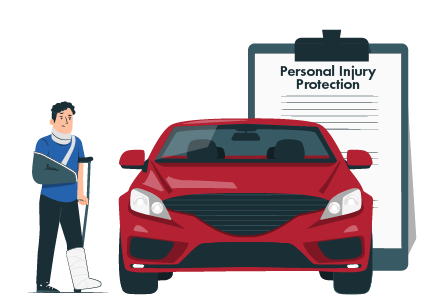Comprehensive car insurance provides financial protection if your car is stolen or damaged in an incident other than a collision. Comprehensive insurance, often called “comp coverage,” is auto insurance that typically covers theft, fire, or falling tree limbs that damage your vehicle.
Consider comprehensive car insurance if you are shopping for a new auto insurance policy, considering getting one, or just reviewing your current auto coverage.
Learn more about comprehensive insurance and how it’s different from collision and liability insurance coverages, how it works, deductibles and limits, and more.
How does Comprehensive Car Insurance Work?
Comprehensive car insurance protects your vehicle financially against damages not caused by a collision. This optional coverage can help you cover your losses and damage in theft, hail, and hitting a critter.
For example, say you parked your car under a large oak tree in your driveway. That evening, a severe thunderstorm rolled through your neighborhood, bringing powerful gusts of wind. As the storm intensified, a massive branch from the oak tree broke off. It fell on your car, causing significant damage to your vehicle.
In this scenario, the insurance would cover the damages to your car caused by the tree branch. Without comprehensive coverage, you would be responsible for the entire loss.
While comprehensive, collision, and liability insurance are all essential components of an auto insurance policy, it is vital to understand their differences. Nearly all states require by law that drivers carry liability insurance for property damage liability and bodily injury liability coverage.
One exception is Florida, where drivers must have liability insurance coverage for property damage and personal injury protection (PIP). However, if you own the car outright, comprehensive and collision car insurance is optional.
Suppose the vehicle is being financed through auto loans or is a lease. In that case, the lender might require you to carry comprehensive insurance on your car.
What does Comprehensive Insurance Cover?
Comprehensive will cover damage to your car in certain situations. Sometimes comprehensive insurance is referred to as “other than collision, “meaning that you and your covered vehicle are protected against certain damages not caused by an incident involving another car.
Some of the comprehensive insurance coverage provided Includes:
- Natural disasters (hurricanes, tornados, and floods)
- Vandalism, fires, and explosions
- Falling objects (hail or tree branches)
- Accidents with animals
- Civil disturbances
- Windshield or glass damage
What Damage is Not Covered by Comprehensive Insurance?
Comprehensive coverage will not extend to damages caused by a vehicle collision.
Comprehensive insurance covers non-collision-related damages such as theft or natural disasters.
Apart from collision-related damages, Comprehensive insurance will not cover the following:
- Car collision: It is essential to understand that comprehensive coverage will not cover a collision with another vehicle, regardless of who is at fault. It is also important to stress that collisions with stationary objects, such as a lamp post, will not be covered.
- Medical Costs: Injuries resulting from any scenario covered by comprehensive coverage. Instead, these costs are covered by another optional add-on to your policy: medical payments coverage or personal injury protection insurance coverage, which would cover medical expenses.
- Legal expenses: any legal fees, such as court fees, will also not be covered by comprehensive coverage.
- Towing fees: If your car breaks down and needs towing, comprehensive coverage will not cover these fees. Instead, policy add-ons such as roadside assistance would be beneficial in this situation.
- Stolen Items: If items get stolen from your car, comprehensive coverage will cover the damage. However, the items stolen will not be covered. Similarly to medical expenses, other policy options are available to cover these losses.
Comprehensive Coverage Deductibles and Limits
When shopping around for comprehensive coverage for your vehicle, you should first consider what your deductible better suits your budget.
In vehicle insurance, a deductible is the amount you are responsible for paying out of pocket toward a covered claim. For example, if you have a $500 deductible and $2,000 worth of damages to your vehicle, you would be responsible for paying the first $500 before your insurance company covers the rest up to your coverage limit.
It is essential to remember that the more risk you are willing to take on, meaning having a higher deductible, the lower your insurance premium. Lower risk for the driver indicates a lower deductible and a higher insurance premium.
Insurance premiums can also vary depending on your driving record and the car’s model and year.
Like any other policy, comprehensive coverage has a limit or a maximum amount your auto insurance company will pay towards a covered claim. This limit is usually the total value of the vehicle.
If your car is stolen, the vehicle insurance will cover it, and the car insurance will reimburse you for your far-depreciated value minus your deductible. Remember that a comprehensive deductible and coverage limit pay for comprehensive insurance claims and differ from your collision deductible and limit.
What’s the Difference Between Collision and Comprehensive Insurance?
Comprehensive auto insurance will only cover vehicle damages caused by theft, vandalism, a natural event, or falling objects. Collision insurance helps you cover the costs of parts, vehicle repair, or a replacement vehicle in case of damage caused by another car or object.
This type of insurance is typically an add-on to your insurance policy if you own your car without a loan. The lender might require comprehensive or collision coverages if your vehicle is leased or financed.
Collision insurance can also cover car damage if it flips over or hits a stationary object like a heavy telephone pole or guard rails. Remember that collision coverage will not cover anything other than a collision.
Similarly, collision insurance has its deductible and limits for collision claims. The higher your deductible, the lower your monthly insurance premium, and vice versa.
Is Comprehensive the Same as Full Coverage?
Full-coverage car insurance is a term lenders use when describing the requirements for an auto insurance policy. It refers to comprehensive and collision car insurance plus state-mandated policy requirements, such as liability. Most insurance providers do not offer anything named “full coverage.” There is not a standard car insurance policy that covers everything.
Why Should You Buy Comprehensive Coverage?
Suppose you are leasing or financing your vehicle. In that case, your lender will likely require you to have auto insurance and a comprehensive policy.
Consider how much your car is worth. Use tools like the Kelly Blue Book, a trusted auto valuation tool, to determine your vehicle’s value. If the value of your car is less than your annual premium, you should talk to your insurance company about a quote and whether this type of coverage makes sense or if there are better coverage options specific to your needs.
Consider your location. Heavily populated areas like cities and towns may have more crime.
How Much Does Comprehensive Coverage Cost?
Multiple factors can impact your comprehensive car insurance quote. The average cost of coverage can range from $134 per year to almost double that amount ($268).
Drivers can also choose their deductible based on their needs and risk perception. Like a trade-in, the higher the deductible, the lower the monthly premiums. It’s essential to consider the car’s cash value; the higher the value, the more expensive the policy will be.
Is Comprehensive Car Insurance Worth it?
Suppose you live in an area with high crime rates or many natural disasters. Comprehensive insurance coverage can financially protect you from paying out of pocket if you are a victim of auto theft or your car suffered weather-related damage.
The downside is that it is the only insurance coverage that this type of policy will provide. Comprehensive and collision insurance can be an expensive combination when purchasing both coverages.
If your car is older or paid off, and crime and weather-related events are not of concern, you could save some money by opting out of this add-on.
The smartest way to find the cheapest car insurance that fits you and your driving records is to get a free quote from Insurance Navy. Insurance Navy will get you protected and back on the road. Call us at 888-949-6289 or request a quote online. You are also welcome to speak with an agent at our locations.
Frequently Asked Questions
Will comprehensive insurance cover a broken windshield?
Comprehensive insurance usually includes glass coverage, which covers broken or cracked windshields. However, policy terms vary by your insurer and state. Some companies may also offer no deductible for windshield repair or replacement.
Does my car’s age affect comprehensive insurance costs?
Yes, the car’s age and value affect comprehensive insurance. Older cars cost less to insure because their lower value means lower claim payouts. So, comprehensive may not be worth it for older cars, so you need a cost-benefit analysis.
Do I have to pay a deductible if I file a comprehensive claim?
Yes, comprehensive claims are subject to a deductible, which you pay before your insurance kicks in. Deductibles vary, and choosing a higher one can lower your premiums. Check your policy documents to avoid surprise expenses during a claim.
Will comprehensive insurance pay for a rental car?
Rental car expenses are not included in comprehensive coverage. Some insurers offer rental reimbursement as an optional add-on with daily limits. If you need access to a temporary vehicle during repairs, consider adding this to your policy.
Will a comprehensive claim affect my insurance rates?
Comprehensive claims may raise your insurance rates, but not as much as collision or at-fault accident claims. Frequent insurance claims of any kind can still increase your rates. Having a claims-free history is the best way to get to lower rates and loyalty discounts.
How do I choose the right deductible for comprehensive insurance?
Choosing the right deductible is a balance between how much you can afford to pay out of pocket vs how much you want to pay in premiums. A higher deductible lowers your monthly payments but increases your immediate liability in case of a claim. Consider your savings and how often and where you drive when making this decision.





